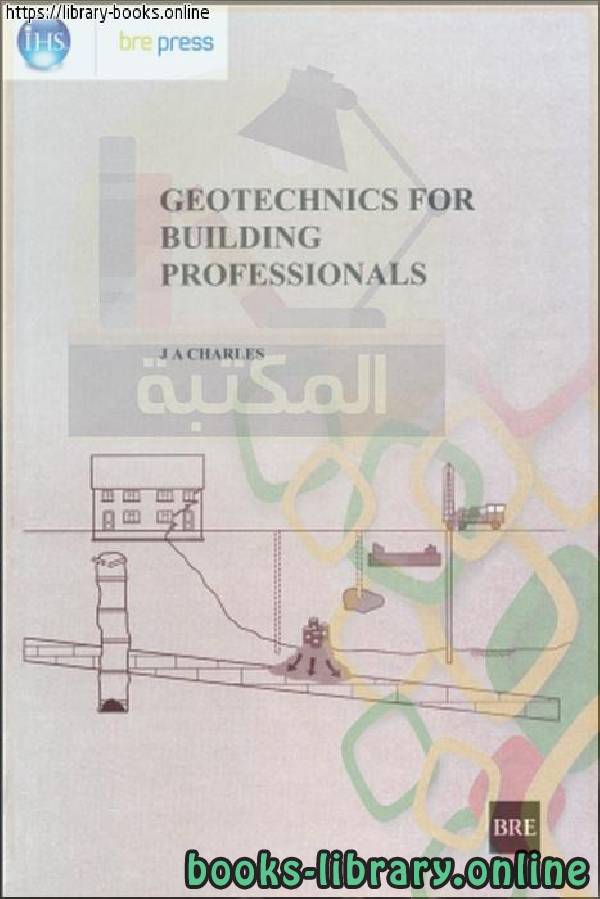📘 ❞ Building Research Establishment-Geotechnics for building professionals ❝ كتاب ــ كاتب غير معروف اصدار 2010
Biology Books - 📖 كتاب ❞ Building Research Establishment-Geotechnics for building professionals ❝ ــ كاتب غير معروف 📖
█ _ كاتب غير معروف 2010 حصريا كتاب ❞ Building Research Establishment Geotechnics for building professionals ❝ عن BRE Bookshop 2025 professionals: نبذه الكتاب: FOREWORD Having been Head of the Division at Building Research Station from 1972 to 1980, it is a particular pleasure for me be invited write this foreword Written nonspecialist, book distillation large reservoir of expertise, experience and guidance on foundations low rise buildings which has accumulated over many years This experience based research into actual behaviour of buildings founded wide range difficult ground conditions, studies effectiveness various ground treatment methods detailed examinations causes and severity damage in hundreds buildings For many, indeed most, structural engineers, geotechnics something black art The ground is mysterious: every trench, hole excavation opened up journey an uncharted underworld When problems with occur, rumours abound – underground streams, old wells, hidden cavities, previous uses site so On one occasion, I visited a foundation Salisbury, bottom had turned soft slurry owing to upward seepage water, was told by engineer that whole Salisbury floating on liquid chalk! Why comes across as mysterious inaccessible subject? For most building materials, such steel, cement, concrete brickwork, stiffness strength can specified and remain reasonably fixed dependable soils, however, depends on stress acting them water pressures within them, these change significantly during after construction In cases, professional cannot specify the founding material but work what nature provided; seldom straightforward To understand methodology geotechnical engineer, helpful compare the approach adopted structural or working ancient A detailed inspection essential discover materials were used how was constructed Special attention given detecting signs weakness defects since can dominate Historical records reveal history give important clues as building’s overall response This demonstrates works exactly same way First, discover what there: ground profile groundwater conditions they vary rise buildings, highly sophisticated testing rarely required; usually necessary know only soil types are (fine coarse material) dense (density indicator of strength) Particular emphasis must placed identifying site, potential hazards Much learned local such as aerial photographs old maps Skimping investigation lead very costly timeconsuming corrective measures, just So Chapter 5 Ground assessment fundamental ‘must read’ Biology Books مجاناً PDF اونلاين Biologically Biology natural science concerned study life, its forms function, organisms interact each other surrounding environment word biology Greek made two words: bio (βίος) meaning life And loggia ( λογία) means Biology: similarity vegetation animal cover edges African American states, existence fossil Branches biology Biology thousands modern began nineteenth century This multiple branches Among are: Anatomy Botany Biochemia Biogeography Biofisia Cytology cell science Ecology environmental science Development Embryology embryology Genetics genetics Histology histology Anthropology anthropology Microbiology bacteriology Molecular Biology Physiology functions organs Taxonemia taxonomy Virology virology Zoology zoology

كتاب
Building Research Establishment-Geotechnics for building professionals
ــ كاتب غير معروف
صدر 2010م عن BRE Bookshop
كتاب
Building Research Establishment-Geotechnics for building professionals
ــ كاتب غير معروف
صدر 2010م عن BRE Bookshop
نبذه عن الكتاب:
FOREWORD
Having been Head of the Geotechnics Division at the Building
Research Station from 1972 to 1980, it is a particular pleasure
for me to be invited to write this foreword. Written for the nonspecialist, this book is a distillation of the large reservoir of
expertise, experience and guidance on foundations for low-rise
buildings which has accumulated at BRE over many years. This
experience is based on research into the actual behaviour of
buildings founded on a wide range of difficult ground
conditions, studies of the effectiveness of various ground
treatment methods and detailed examinations of the causes and
severity of damage in hundreds of buildings.
For many, indeed most, building professionals and structural
engineers, geotechnics is something of a black art. The ground
is mysterious: every trench, hole and excavation opened up is a journey into an uncharted
underworld. When problems with foundations occur, rumours abound – underground streams, old
wells, hidden cavities, previous uses of the site and so on. On one occasion, I visited the site of a
foundation excavation in Salisbury, the bottom of which had turned into a soft slurry owing to
upward seepage of water, and was told by an engineer that the whole of Salisbury was floating on
liquid chalk!
Why is it that geotechnics comes across as a mysterious and inaccessible subject? For most building
materials, such as steel, cement, concrete and brickwork, the stiffness and strength can be specified
and remain reasonably fixed and dependable. For soils, however, the stiffness and strength depends
on the stress acting on them and the water pressures acting within them, and these can change
significantly during and after construction. In most cases, the professional cannot specify the
founding material but has to work with what nature has provided; and nature is seldom
straightforward.
To understand the methodology of the geotechnical engineer, it is helpful to compare it with the
approach adopted by a structural engineer or building professional working on an ancient building. A
detailed inspection is essential to discover what materials were used and how the building was
constructed. Special attention is given to detecting signs of weakness and defects since these can
dominate behaviour. Historical records can reveal the history of construction and give important clues
as to the building’s overall response.
This book demonstrates that the geotechnical engineer works in exactly the same way. First, discover
what is there: the ground profile and groundwater conditions at the site and how they vary across it.
For low-rise buildings, highly sophisticated testing is rarely required; it is usually necessary to know
only what the soil types are (fine or coarse material) and how dense they are (density is an indicator
of stiffness and strength). Particular emphasis must be placed on identifying previous uses of the site,
potential hazards and difficult ground. Much can be learned from local experience and records such
as aerial photographs and old maps. Skimping on the investigation can lead to very costly and timeconsuming corrective measures, just as they can for an ancient building. So Chapter 5 Ground
assessment is fundamental to the whole book and is a ‘must-read’.
#2K
86 مشاهدة هذا اليوم#63K
5 مشاهدة هذا الشهر#70K
4K إجمالي المشاهدات- 🎁 كن أول كاتب اقتباس في هذه الصفحة واحصل على هديّة 15 من النقاط فوراً 🎁
-
كتب أخرى لـ كاتب غير معروف:
-



